WWDC 2005 - Apple to Move to Intel Processors in 2006
by Anand Lal Shimpi on June 6, 2005 3:03 PM EST- Posted in
- Trade Shows
Steve talked about the two major challenges with the shift to x86:
At the conference, Apple released an updated version of their Xcode development suite. Xcode 2.1 will let you compile to both PowerPC and Intel architectures, creating a universal binary and allowing developers to ship one copy of software that supports both processors.
- Getting Mac OS X run on Intel
- Intel versions of Applications

OS X has been living a secret double life for the past 5 years.
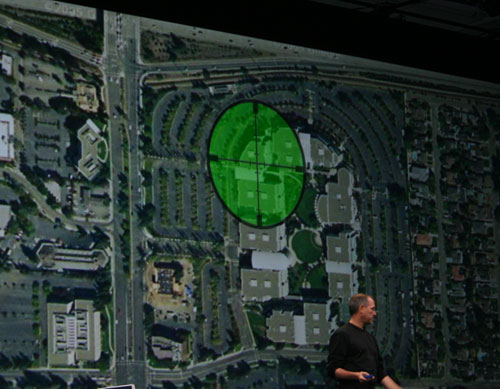
This picture highlights the building on Apple's Cupertino campus where x86 development has taken place for the past 5 years.
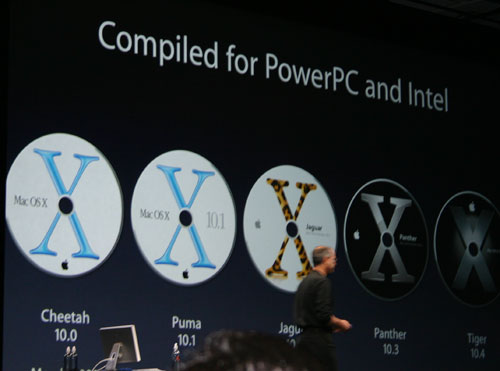
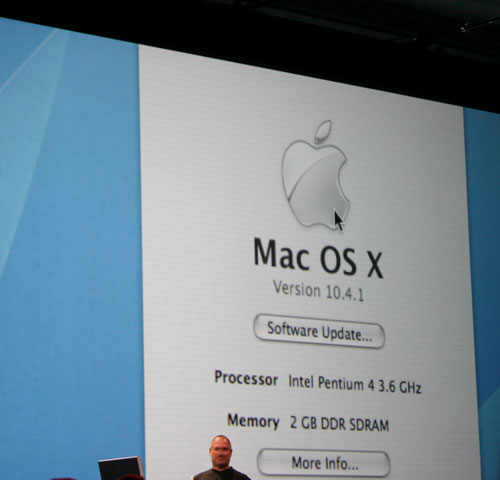
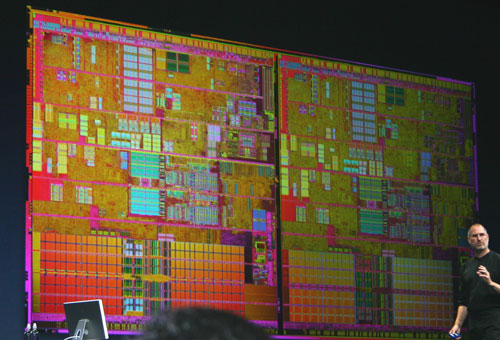
At the conference, Apple released an updated version of their Xcode development suite. Xcode 2.1 will let you compile to both PowerPC and Intel architectures, creating a universal binary and allowing developers to ship one copy of software that supports both processors.
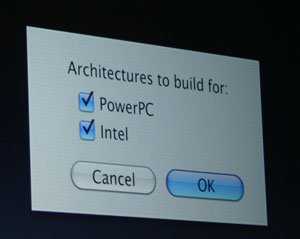
A checkbox in Xcode 2.1 will allow developers to create a universal binary that will run on both PPC and Intel platforms.
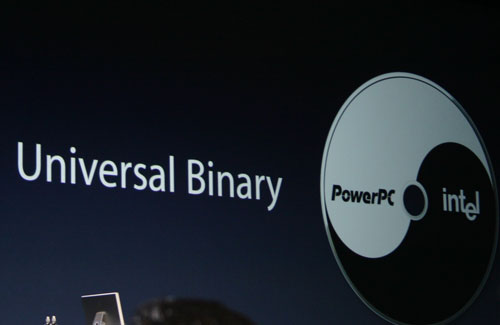

The transition in architectures will be an overlapping one.



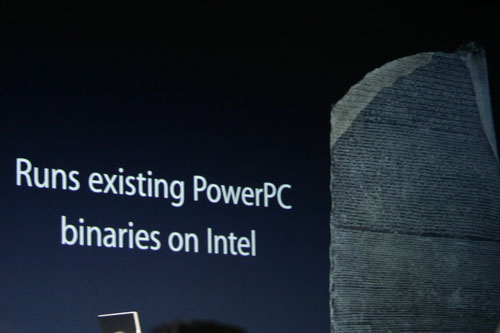
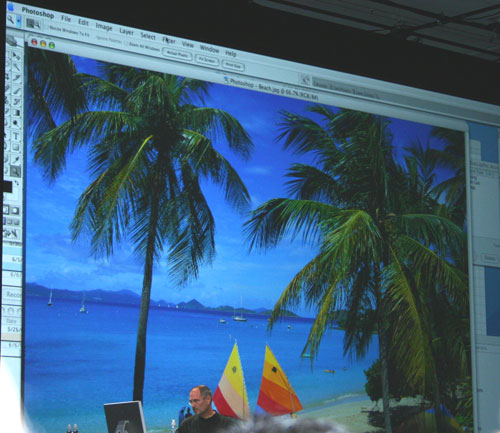
OS X (PowerPC) Photoshop running on an Intel OS X system using Rosetta.
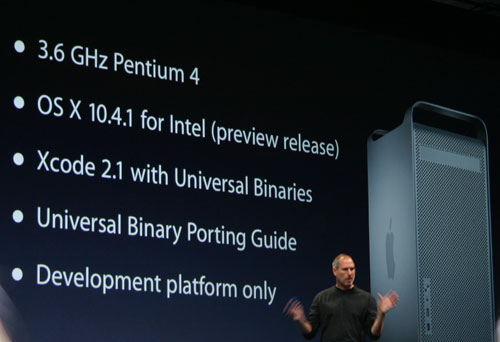
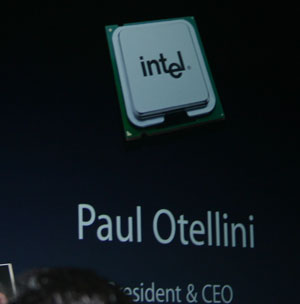

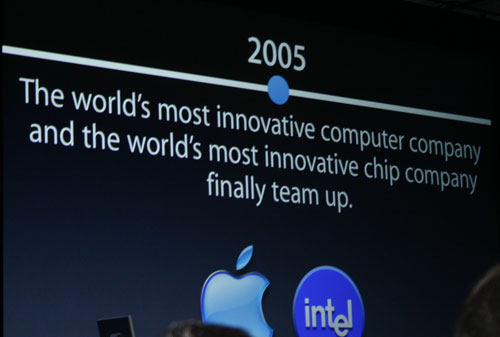
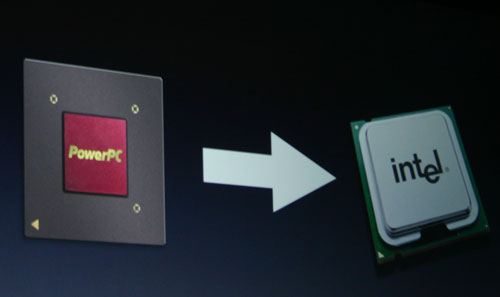










65 Comments
View All Comments
slatr - Tuesday, June 7, 2005 - link
This may be an indicator of Apple's wish to continue to be the digital hub of your living room.**********
Interesting.. ATI/IBM/MICROSOFT, NVIDIA/IBM/SONY
, ?/INTEL/APPLE
They all want to do this living room do all box.. will intel supply graphics chips too I wonder..
aliasfox - Tuesday, June 7, 2005 - link
I personally would be impressed if Apple released a Dothan based Mac Mini for ~$499 at MacWorld Paris (September). Small, quiet, fast, *and* can dual boot OSX and Windows.I would actually be even more impressed if Xcode could compile universal binaries for OSX PPC, OSX X86, *and* Windows X86.
Sadly, I can still only see hardware sells get smaller. Currently, the processor upgrade market for Macs is relatively small, as upgrades are literally hundreds of dollars (a 2.0 GHz G4 upgrade costs something like $400-500, if I recall correctly). If I buy an Intel based Mac and want a faster processor a year or two down the road, I don't need to buy a new Mac anymore, I'll just look towards NewEgg for a $150 Pentium.
Support is far too big of an issue for Apple to deal with opening up OSX to the rest of the world. Currently, Apple only has to worry about three processors, and most likely one chipset for each (G3, G4, G5). On the Intel side, Apple will have to worry about just what Intel produces. Going A64 or opening up the software for use anywhere would mean having to support ATi's, nVidia's, VIA's, SIS's, and hundreds of other off brand chipsets. Of course, Apple will also end up having to field calls from irate Dell users wondering why OSX won't install on their systems.
I can't see Apple holding the same price premium as they have in the past (on the desktop side, at least- their laptops are more or less competitive in everything but processors). Would you pay an extra $100-200 for a machine that's elegant, quiet, and made of sturdy materials? I'd consider it.
Or another analogy: Your average PC is a Camry, the Mac version is an ES300. Same drivetrain, the Lexus has a classier look and feel.
equinox76 - Tuesday, June 7, 2005 - link
AMD simply doesn't have the manufactuiring capability to compete with Intel. They might have a better product right now but if it can't be delivered, what good is it ??piroroadkill - Tuesday, June 7, 2005 - link
#54, Anand said PRESENTLY, if you even bother to read what you quoted, dickwad.smn198 - Tuesday, June 7, 2005 - link
#54 I wish you didn't read them too.Calin - Tuesday, June 7, 2005 - link
Apple choose Intel mainly for the cheaper dual core processors (my idea). When selling computers at the same price point, there is a great advantage in paying 100s of $ less for processor (or processors). Also, Intel certainly has the resources to at least keep up enough with AMD regarding processor speed/heat/capabilities.vertigo1 - Tuesday, June 7, 2005 - link
If you think about it, what will Apple Machines be used for? Video and graphics editing and this uses... encoding?So even though everyone here seems to kiss Amds feet.... I think that Apple chose correctly given the situation.
Kagjes - Tuesday, June 7, 2005 - link
-Hmmm, a thought crossed my mind. What would it take for MacOS to support DirectX?Kagjes - Tuesday, June 7, 2005 - link
i think this is one of those situations where things could go in million different ways. Just depends on the reactions of the biggest players. All of the speculations are both right and wrong. But one thing is for sure. I love the way things are going, and Macs getting closer to the hectic and sometimes chaotic x86 market is really an explosive combination. One thing is for sure. For macs, being able to run WinXP and play games AND keep their own OS at the same time is an edge that can't be matched. I would really like to have one of those.Dekay - Tuesday, June 7, 2005 - link
I understand why apple working with intel could make more sense. This move from apple also means an enrichment in the software department. But I think more anaemia in the CPU department can become problematic and intel more a "monopolist" (I am exaggerating a little bit). And in the end that is not good for us, remember the times before K7? We can continue to discuss whether the chips from amd/intel are better or roughly similar but a <20% market share (and only slowly rising) for AMD is not a good sign.